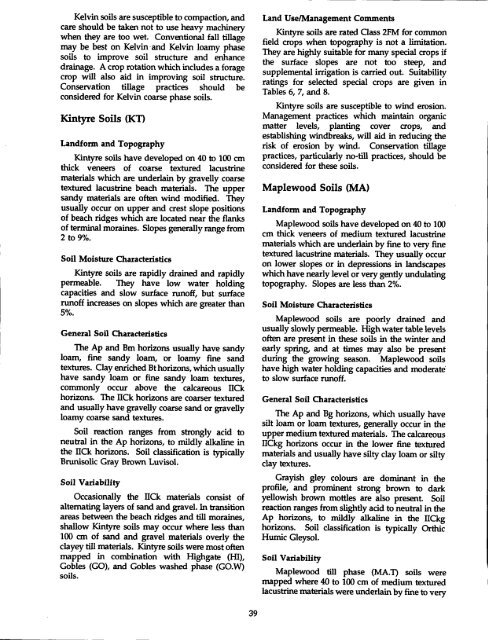The Soils of Elgin County - Agriculture and Agri-Food Canada
The Soils of Elgin County - Agriculture and Agri-Food Canada
The Soils of Elgin County - Agriculture and Agri-Food Canada
- No tags were found...
Create successful ePaper yourself
Turn your PDF publications into a flip-book with our unique Google optimized e-Paper software.
Kelvin soils are susceptible to compaction, <strong>and</strong>care should be taken not to use heavy machinerywhen they are too wet. Conventional fall tillagemay be best on Kelvin -<strong>and</strong> Kelvin loamy phasesoils to improve soil structure <strong>and</strong> enhancedrainage . Acrop rotation which includes a foragecrop will also aid in improving soil structure .Conservation tillage practices should beconsidered for Kelvin coarse phase soils.Kintyre <strong>Soils</strong> (KT)L<strong>and</strong>form <strong>and</strong> TopographyKintyre soils have developed on 40 to 100 cmthick veneers <strong>of</strong> coarse textured lacustrinematerials which are underlain by gravelly coarsetextured lacustrine beach materials . <strong>The</strong> uppers<strong>and</strong>y materials are <strong>of</strong>ten wind modified. <strong>The</strong>yusually occur on upper <strong>and</strong> crest slope positions<strong>of</strong> beach ridges which are located near the flanks<strong>of</strong> terminal moraines. Slopes generally range from2 to 9%.Soil Moisture CharacteristicsKintyre soils are rapidly drained <strong>and</strong> rapidlypermeable. <strong>The</strong>y have low water holdingcapacities <strong>and</strong> slow surface run<strong>of</strong>f, but surfacerun<strong>of</strong>f increases on slopes which are greater than5% .General Soil Characteristics<strong>The</strong> Ap <strong>and</strong> Bm horizons usually have s<strong>and</strong>yloam, fine s<strong>and</strong>y loam, 'or loamy fine s<strong>and</strong>textures . Clay enriched Bt horizons, which usuallyhave s<strong>and</strong>y loam or fine s<strong>and</strong>y loam textures,commonly occur above the calcareous IICkhorizons. <strong>The</strong> IICk horizons are coarser textured<strong>and</strong> usually have gravelly coarse s<strong>and</strong> or gravellyloamy coarse s<strong>and</strong> textures .Soil reaction ranges from strongly acid toneutral in the Ap horizons, to mildly alkaline inthe IICk horizons. Soil classification is typicallyBrunisolic Gray Brown Luvisol .Soil VariabilityOccasionally the IICk materials consist <strong>of</strong>alternating layers <strong>of</strong> s<strong>and</strong> <strong>and</strong> gravel . In transitionareas between the beach ridges <strong>and</strong> till moraines,shallow Kintyre soils may occur where less than100 cm <strong>of</strong> s<strong>and</strong> <strong>and</strong> gravel materials overly theclayey till materials . Kintyre soils were most <strong>of</strong>tenmapped in combination with Highgate (HI),Gobles (GO), <strong>and</strong> Gobles washed phase (GO.W)soils.L<strong>and</strong> Use/Management CommentsKintyre soils are rated Class 2FM for commonfield crops when topography is not a limitation .<strong>The</strong>y are highly suitable for many special crops ifthe surface slopes are not too steep, <strong>and</strong>supplemental irrigation is carried out . Suitabilityratings for selected special crops are given inTables 6, 7, <strong>and</strong> 8.Kintyre soils are susceptible to wind erosion.Management practices which maintain organicmatter levels, planting cover crops, <strong>and</strong>establishing windbreaks, will aid in reducing therisk <strong>of</strong> erosion by wind. Conservation tillagepractices, particularly no-till practices, should beconsidered for these soils .Maplewood <strong>Soils</strong> (MA)L<strong>and</strong>form <strong>and</strong> TopographyMaplewood soils have developed on 40 to 100cm thick veneers <strong>of</strong> medium textured lacustrinematerials which are underlain by fine to very finetextured lacustrine materials . <strong>The</strong>y usually occuron lower slopes or in depressions in l<strong>and</strong>scapeswhich have nearly level or very gently undulatingtopography. Slopes are less than 2%.Soil Moisture CharacteristicsMaplewood soils are poorly drained <strong>and</strong>usually slowly permeable . High water table levels<strong>of</strong>ten are present in these soils in the winter <strong>and</strong>early spring, <strong>and</strong> at times may also be presentduring the growing season . Maplewood soilshave high water holding capacities <strong>and</strong> moderateto slow surface run<strong>of</strong>f.General Soil Characteristics<strong>The</strong> Ap <strong>and</strong> Bg horizons, which usually havesilt loam or loam textures, generally occur in theupper medium textured materials . <strong>The</strong> calcareousIICkg horizons occur in the lower fine texturedmaterials <strong>and</strong> usually have silty clay loam or siltyclay textures .Grayish gley colours are dominant in thepr<strong>of</strong>ile, <strong>and</strong> prominent strong brown to darkyellowish brown mottles are also present. Soilreaction ranges from slightly acid to neutral in theAp horizons, to mildly alkaline in the IICkghorizons . Soil classification is typically OrthicHumic Gleysol.Soil VariabilityMaplewood till phase (MAJ) soils weremapped where 40 to 100 cm <strong>of</strong> medium texturedlacustrine materials were underlain by fine to very39
















